Table of Contents
- What is DOSBox?
- Step 1: Downloading & Installing
- Step 2: Configuration
- Step 3: Running DOSBox & Using the Command Line
- Step 4: Troubleshooting
What is DOSBox?
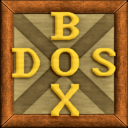 DOSBox is an emulator program which emulates an IBM PC compatible computer running a DOS operating system. Many IBM PC compatible graphics and sound cards are also emulated. This means that original DOS programs (including PC games) are provided with an environment in which they can run correctly, even though the modern computers have dropped support for that old environment. [Wikipedia] DOSBox is the standard way to play DOS games on modern computers. It has been compiled for Windows, Mac, Linux, and many other operating systems and platforms. It is free software released under a GNU General Public License.
DOSBox is an emulator program which emulates an IBM PC compatible computer running a DOS operating system. Many IBM PC compatible graphics and sound cards are also emulated. This means that original DOS programs (including PC games) are provided with an environment in which they can run correctly, even though the modern computers have dropped support for that old environment. [Wikipedia] DOSBox is the standard way to play DOS games on modern computers. It has been compiled for Windows, Mac, Linux, and many other operating systems and platforms. It is free software released under a GNU General Public License.
Step 1: Downloading & Installing
Download DOSBox v0.74-2 for your operating system or platform:
Download official DOSBox Installer: Pre-configured .conf files:Alternate Versions:
There are also some alternative versions of DOSBox available, based on the official source but improved with specific features:
DOSBox ECE (Enhanced Community Edition): Features include 3Dfx Vooodoo card emulation, enhanced pixel-perfect scaling (4x, 5x, 6x), improved sound emulation, and more. (Windows, Linux)
DOSBox SVN Daum: Features include save states, graphical shaders, vertical sync, CPU flags optimization, additional DOS commands (PROMPT VOL, LABEL, MOUSE, etc) and more. (Windows, OSX, Linux; the project has not been updated since 2015.)
Run the installation program; you will see a screen like this:
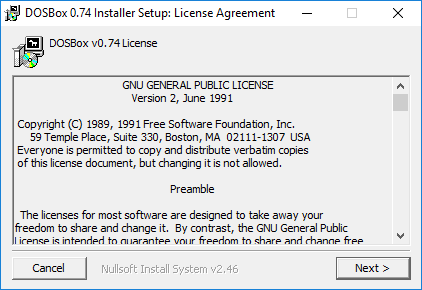
Note that this guide focuses on Windows, but the process is similar on Mac, Linux, and other computer-based operating systems. Simply click Next, then Next again (change the installation location if you want), then Install to complete the process.
DOSBox on Android & iOS devices: DOSBox is also available for Android and iOS for mobile devices. There are MANY versions available on the Android app store and each will work slightly differently, choose one that looks promising and try it out. The process for iOS is a bit trickier since Apple doesn't want you using programs like this. There is a Guide to installing DOSBox on iOS but I can't confirm that it works and be warned the process may be dangerous if you don't know what you're doing!
Step 2: Configuration
Without any configuration, DOSBox will run just fine and play most games. However its settings may not be to your preferences. DOSBox's settings are stored in the dosbox-0.74.conf file. On Windows this file is located in \Users\[your-user-name]\AppData\Local\DOSBox. You can edit it by clicking the "DOSBox 0.74 Options" link in your Start menu, or opening it in your favorite text editor. By default, the Start menu link will likely open the DOSBox configuration file in Notepad:
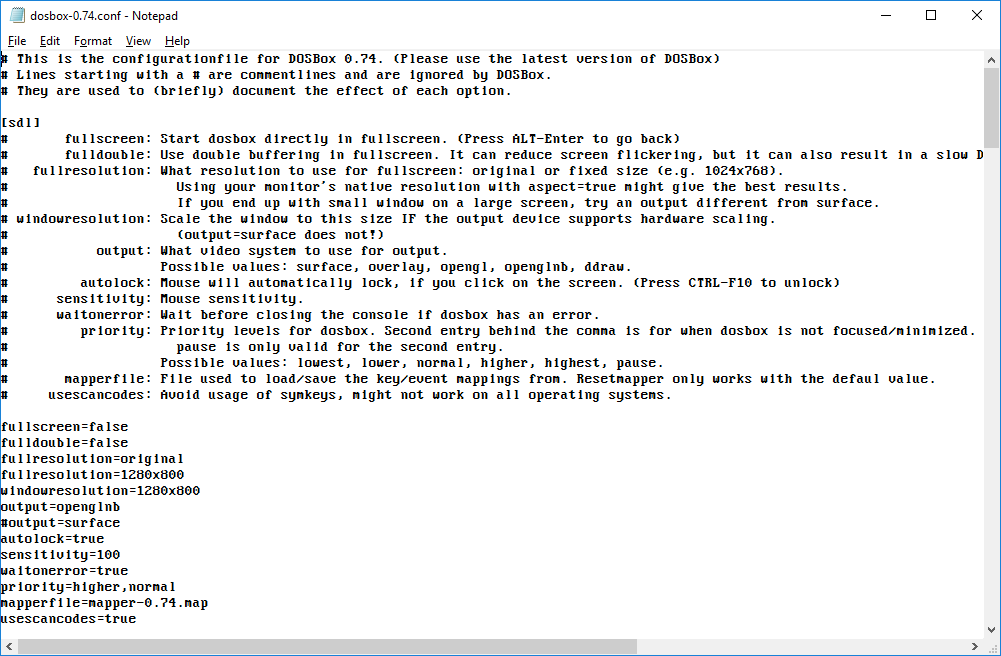
As you scroll through the file, there are numerous options that you can set. A line beginning with a hash (#) is a comment and is not executed, it's there for your information only. For full details of every option available, see the DOSBox.conf wiki page. For most users, the default options will work well, with the exception of the graphical display, CPU cycles, and autoexec (auto-mounting of drives). (CPU cycles controls how fast or slow DOSBox runs. Many old games will run too fast unless the cycles setting is set properly.)
DOSGames.com Pre-set Configs
If you'd prefer to not mess with settings, you can download and save one of these pre-set configuration files. These files assume your games are stored in the C:\DOS directory; if not, modify the line right near the bottom to change it to wherever your files are stored.
Simply rename file to "dosbox-0.74.conf" and place it in your \Users\[your-user-name]\AppData\Local\DOSBox folder.
Video Modes
When DOSBox is running, you can press Alt-Enter to switch between full screen and windowed mode at any time.
Default to full screen: To specify that DOSBox always open in full screen, change the fullscreen=false line to fullscreen=true. You will also need to make sure that output is set to "surface". To always open DOSBox in full screen mode, the [sdl] section (at the top of the file) should be something like:
fullscreen=true
fulldouble=false
fullresolution=original
windowresolution=1280x800
output=surface
autolock=true
sensitivity=100
waitonerror=true
priority=higher,normal
mapperfile=mapper-0.74.map
usescancodes=trueWindow size: Depending on the resolution of your screen, the default in widowed mode of x2 size (so a game with a native resolution of 320x200 would be shown as 640x400) might be too small. To increase the magnification, first set the [sdl] values to something like this:
fullscreen=false
fulldouble=false
fullresolution=original
fullresolution=1280x800
windowresolution=1280x800
output=openglnb
#output=surface
autolock=true
sensitivity=100
waitonerror=true
priority=higher,normal
mapperfile=mapper-0.74.map
usescancodes=trueThen set the values in the [render] section to something like:
frameskip=0
aspect=false
scaler=normal3xThis would set the window size to x3 normal. There are other options listed for "scaler" in the DOSBox conf file comments, you can try various values to see which one you like best.
Cycles
"Cycles" refers to the "amount of instructions DOSBox tries to emulate each millisecond." It's expressed as a number, so the higher the number, the faster computer DOSBox will simulate. The exact number of cycles to make a game run as intended will vary based on how fast your own computer is.
To change the number of cycles, you can use the CTRL-F11 (slower) and CTRL-F12 keys:
CTRL-F11: - Decrease speed (game goes slower)CTRL-F12: + Increase speed (game goes faster)
You can also set the cycles at the command prompt, using the command cycles [value] where [value] is one of the following:
auto: The default, DOSBox tries to "guess" at an appropriate number. Okay for most games.max: Sets the number to the highest possible. Good for games that are running too slowly.
#: You can also set it to a specific number. Say a game is running too fast; set it to something low, like 300. If a game is too slow, increase it to say 22000.
Finally, there is also the option to set the number of default cycles in the conf file. Find the cycles= line and change it to one of the values above.
Autoexec
The section at the very bottom is the [autoexec] section, named after the autoexec.bat file which would execute automatically (auto-exec) every time you started up your DOS computer. Here you can put lines to automatically mount your drive(s). By default, DOSBox dumps you to a Z: prompt with nothing in it. You need to "mount" your C: drive and any other drives that you want to use. The line to do so is like so:
mount c c:\dos\
c:The first line sets the c:\dos\ folder as your C: drive. If your games are stored elsewhere, put the full path to that location. (It's easiest if you store all your DOS games in one place.) The second line changes the current drive to C:. You could type these commands every time you start DOSBox, but by putting them in your [autoexec] section, they will happen automatically. To set up a CD-ROM drive, add another mount line but add the -cdrom parameter, like "mount d d:\ -cdrom".
As per the the warning message in DOSBox, it is highly recommended that you do NOT mount your root C:\ drive. (Mounting a CD-ROM as root, as in the example above with the D: drive, is okay.) Although mounting C:\ can be convenient, this means that programs you run have access to all of your computer's files, and could potentially delete or modify anything on your drive. Mounting a subfolder (ex, C:\DOS) means programs cannot "see" anything outside that subfolder, so that's always safer than mounting C:\ directly.
Game Setup
In general when you download games from DOSGames.com, they will already be ready to run in DOSBox, especially if the filename is in the format DOSBOX_GAME.ZIP. (These files have been re-archived and pre-configured so that they're ready to go!) Most other games you download will run without problems. Some games may require running a separate setup program before playing; try looking for a file like SETUP.EXE, CONFIG.EXE or SETSOUND.EXE. Run that, then try running the game again.
If a game's setup includes sound setup, choose SoundBlaster (or SoundBlaster 2.0 or something similar) and use the following values: Address: 220. Interrupt: 7. DMA: 1. These are the DOSBox defaults.
Step 3: Running DOSBox & Using the Command Line
If everything is configured correctly, when you run DOSBox you'll see something like this:
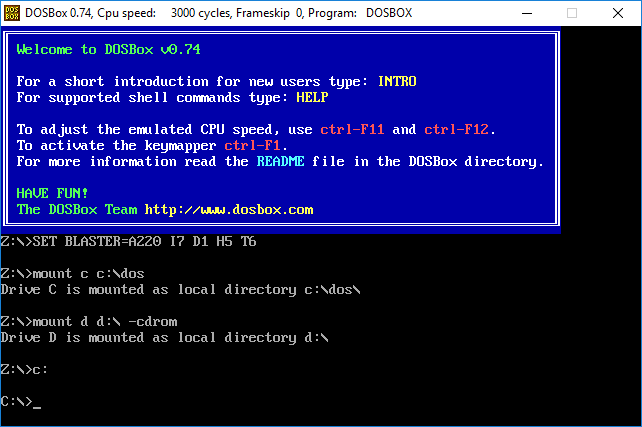
DOS Commands
Now you will need to use some simple DOS command prompt commands to navigate to the correct directory (folder) and run the game. If you've used DOS before (or Windows Command Prompt) this should be easy. If not, here are some basic commands:
CD [directory] - Change directory - Use this command to change to a sub-directory of your current directory. So if you are in C:\ (ex, you mounted your C:\DOSGAMES directory as C:\ in DOSBox) and want to play Commander Keen which is in your C:\KEEN directory in DOSBox (in C:\DOSGAMES\KEEN on your actual hard drive) you would type cd keen and press Enter.
CD .. - Change to parent directory - Use this special version of the CD command to go to the parent directory. So if you are in C:\DOOM and type cd .. you will then be in C:\.
DIR - Directory listing - Use this command to display a list of files in a directory. Add the /w option (dir /w) to display a more compact view. Add the /p option (dir /p) to pause the screen at the end of each page. You can also list all files of a certain type with a command like dir .exe (shows all executable files in the current directory).
[filename.EXE/COM/BAT] - Run the game - There are three kinds of files you can run in DOS. The most common is .EXE. A second less common is .COM. A third is .BAT, which is actually a list of several commands that run in sequence. The file that starts the game will likely be a .EXE file, although if a .BAT file exists, you can also try that. If neither exists, look for a .COM file. (Note that you don't need to type the extension; so to run PLAYME.EXE you can just type PLAYME.)
Typical Usage
Typically after running DOSBox, you will use a CD [directory] command to change to the directory of the game you want to play, then type [name of .exe/com/bat file] to start the game. Type DIR to list the files if you forget which file to run.
More info on DOS commands: For a full list of DOS commands and much more details, see Computer Hope's Basic overview of MS-DOS commands
The Game is On!
After running the game, hopefully it will start up and you can begin to play!
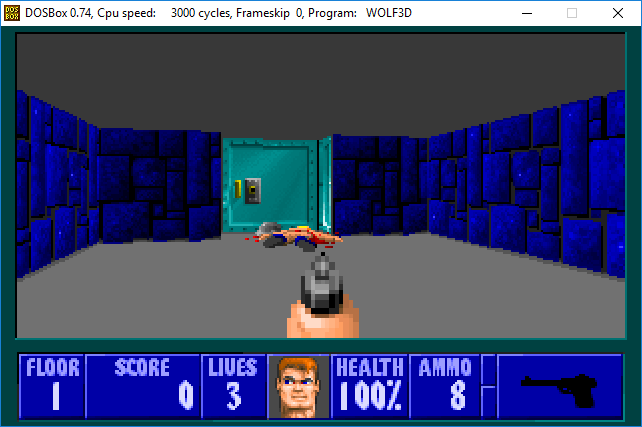
In-game Hotkeys
Here are some common hotkeys that you may find useful:
ALT-ENTER Toggle full-screen modeALT-PAUSE Pause emulation (ALT-F16 on OSX)
CTRL-F10 Unlock the mouse from the DOSBox window (alternate: Windows key)
CTRL-F11 - Decrease speed (game goes slower)
CTRL-F12 + Increase speed (game goes faster)
Full list: See the DOSBox Special Keys page for a full list.
Step 4: Troubleshooting
If you have having difficulty getting a particular game working:
1. First check to see if the game is listed on the DOSBox Compatibility List. Some games simply will not work in DOSBox.
2. If the game is marked on the compatibility list as playable (or not listed) try the troubleshooting tips in the DOSBox FAQ.
3. If neither of those work, try posting a message on the Get Games to Work area of the forum, or at the official DOSBox Forum @ vogons.org, and hopefully someone can help you out.